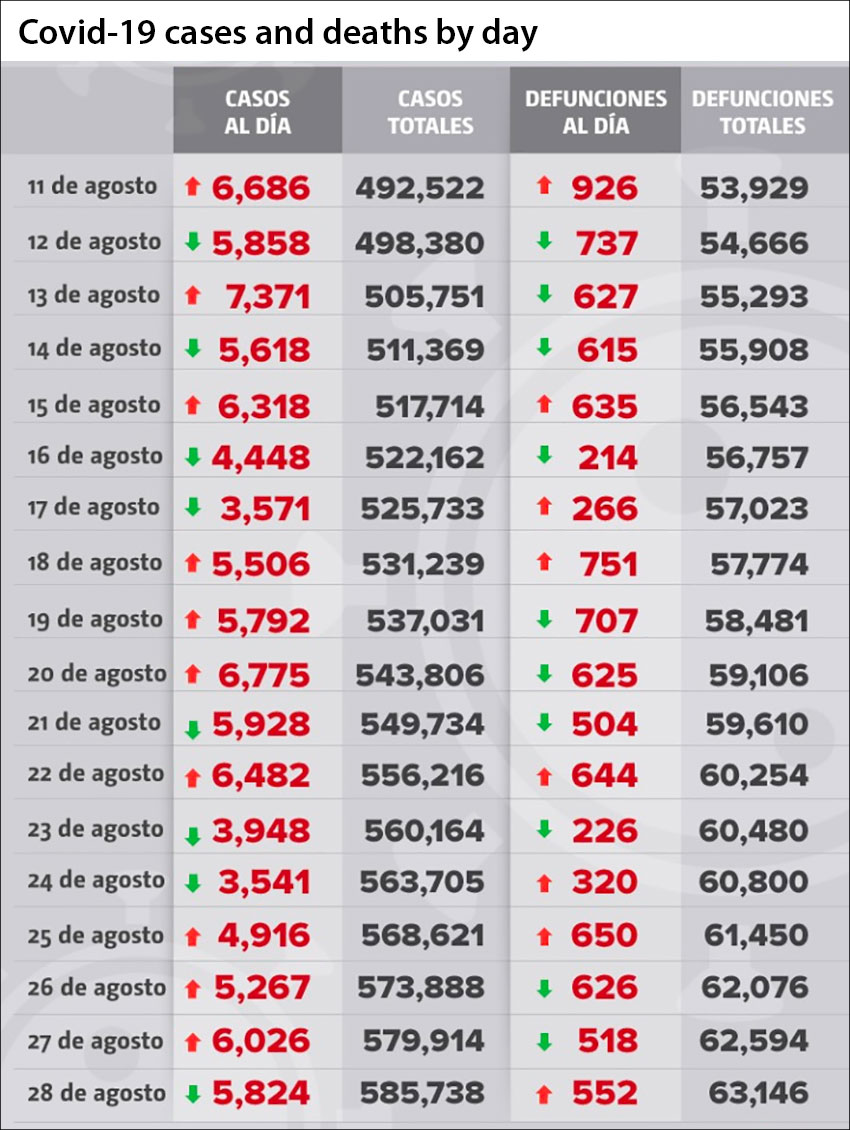The risk of coronavirus infection will be yellow light “medium” in 10 states as of Monday, the Health Ministry announced Friday, while Colima will be the only state at the red light “maximum” risk level.
Health Promotion chief Ricardo Cortés presented a new coronavirus “stoplight” risk map that showed that Campeche, Tabasco, Chiapas, Oaxaca, Guerrero, Tlaxcala, Veracruz, Tamaulipas, Chihuahua and Sonora will start next week as yellow light states.
The only state that is yellow on the “stoplight” map currently in effect is Campeche, which switched to that color on August 17. Cortés said the 10 yellow light states now look forward to reaching the green light “low” risk level.
The nine states switching from orange to yellow on Monday will be able ease coronavirus restrictions with the federal government’s blessing.
Each stoplight color is accompanied by recommended restrictions to slow the spread of the virus but some states have chosen to follow their own guidelines rather than those drawn up by federal authorities.

The new “stoplight” map showed that 21 states will start next week as orange light “high” risk states.
They are Aguascalientes, Baja California, Baja California Sur, Coahuila, Durango, Guanajuato, Hidalgo, Jalisco, Michoacán, Mexico City, México state, Morelos, Nayarit, Nuevo León, Puebla, Querétaro, Quintana Roo, San Luis Potosí, Sinaloa, Yucatán and Zacatecas.
The risk level has been downgraded from red to orange in five of those states – Aguascalientes, Baja California Sur, Hidalgo, Nayarit and Zacatecas.
Cortés urged residents of orange light states to continue acting with caution in order to slow the spread of the coronavirus and thus allow the risk infection level to be reduced.
The infection risk level in Colima, now the sole red light state, remains at maximum because case numbers, hospital admissions and Covid-19 deaths are still trending upwards, the health official said. The small Pacific coast state has recorded a total of 3,542 confirmed coronavirus cases and 414 Covid-19 deaths.
Cortés explained that the new “stoplight” map was formulated for the first time using 10 different indicators, rather than four, to assess the risk level in each state.

The 10 indicators are: the Covid-19 effective reproduction rate (how many people each infected person infects); estimated case numbers per 100,000 inhabitants; the weekly positivity rate (the percentage of Covid-19 tests that come back positive); total case numbers; the number of coronavirus patients per 100,000 inhabitants; hospital occupancy rates for general care beds; occupancy rates for beds with ventilators; hospital admission trends; Covid-19 mortality rate (deaths per 100,000 inhabitants); and Covid-19 death trends (whether the number of deaths per week is increasing or decreasing).
Earlier in Friday night’s press briefing, Cortés reported that Mexico’s accumulated case tally had increased to 585,738 with 5,824 new cases registered.
Confirmed case numbers have trended downwards in recent weeks but fewer than 3,000 cases have not been reported on a single day since June 8.
The Health Ministry estimates that there are currently 42,822 active cases across the country while the results of 83,357 Covid-19 tests are not yet known.
The official Covid-19 death toll rose to 63,146 on Friday with 552 additional fatalities registered. National data shows that 36% of general care hospital beds set aside for coronavirus patients are currently occupied while 31% of those with ventilators are in use.
Friday marked six months since Mexico’s first two cases of Covid-19 were reported. The two first cases were men who had traveled to Italy.
Mexico currently has the eighth highest case tally in the world, according to data compiled by Johns Hopkins University, and the third highest Covid-19 death toll after the United States and Brazil.
Source: El Universal (sp), El Financiero (sp)
